This week I’m doing a different kind of Forgotten New York page in that I’m not presenting any historic obscurities, overlooked neighborhoods, or ignored aspects of NYC physiognomy. No, I’m just going to show my neighborhood — the way I found it when I first moved in, and what it’s becoming.
Young Flushing
Queens history pictorial books show a tidy, orderly neighborhood of wide lawns, shade trees, and diverse, variegated architecture built on a two-story-with-attic template; most were built beginning in the first decade of the 1900s by firms such as the Rickert-Finlay Company, which developed properties with strictures requiring lots of a certain size, peaked roofs, and above all, relaxed openness. Rickert-Finlay developed a vast swath of northern Queens still renowned for a suburban atmosphere from Flushing to Little Neck.
When I first moved to Flushing in 1993 after a Bay Ridge boyhood and young adulthood, I found a divided, yet stable neighborhood. The closer to Main Street you were, the more crowded and congested it was. The small houses and large plots nearer Main Street had disappeared, replaced by huge apartment buildings or smaller ones bereft of any green space in front. In my area, 159th Street south of the LIRR, there was still a semblance of suburbia. It is quickly being eroded.
The scenes above show Main Street just south of Northern Blvd. (called Bridge Street when the photo was taken around 1900), Amity Street, now Roosevelt Avenue, and South 14th Street, now 154th.
As I Found Flushing


I photographed these two leftovers from the sensibilities of 1905 on Roosevelt Avenue shortly after I arrived in Flushing in 1993. Within a couple of years they would be replaced by the “objects” similar to what you will see later on in this webpage. When they were built, no two buildings were to look the same and all featured wide lawns, and as you see on the right, big shade trees were planted either in front or in back, or perhaps both.

Though not a part of the Rickert-Finlay development, this 45th Avenue building conforms closely to the developers’ vision.

This Cherry Avenue porched and peaked house is down on its luck. It still has its original bluestone sidewalk; and it also has a for sale sign. Does demolition or restoration await it?

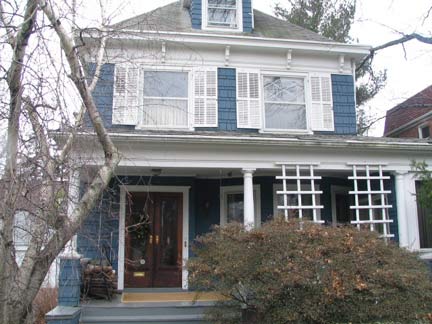
This beautiful building, Cherry Avenue just east of Parsons Boulevard, can be found just east of Waldheim, which is already being dismembered by a combination of developers with no esthetic taste, politicians without spines, and landowners who do not value what they own.
The Dozers Arrive
I can’t pinpoint the exact date. Doctors can never say when illness first appears in the body; they can only treat the disease or at least alleviate its pain. No, the destruction of Old Flushing and the arrival of New Flushing were more a matter of gradual infiltration. A house here, a house there, and then an entire block would go. Wooden plywood boards appear around a building and then the ‘dozers appear. Homeowners are offered vast, inflated sums for their property. Who can resist?

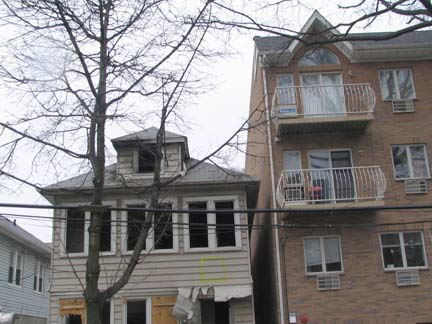
Maybe there will be a little constructive arson to speed things along, perhaps like here, on Cherry Avenue between Union and Robinson.

Sanford Avenue and 149th Street
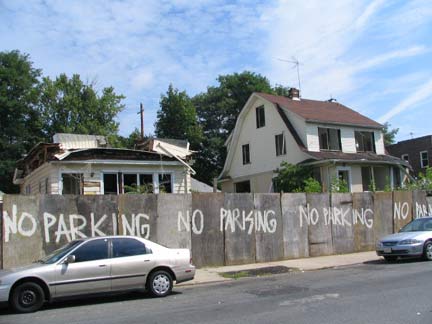
Station Road and 161st Street
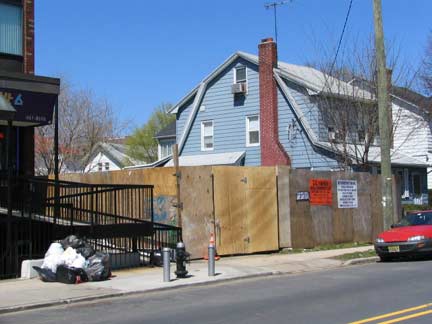
162nd Street north of 43rd Avenue
The homes shown in these photos were not blighted, were not rundown, were by no means a detriment to Flushing’s appearance. Their replacements will be.
They were, however, impediments to what the developers of New Flushing have in mind for my neighborhood: the institution of multifamily “worker barracks” for a population apparently increasing by Malthusian lengths.
At a demo site a few yards away from chez webmaster, the plywood boards are still there…maybe the developer ran out of money after taking down the house, which often happens, and the lots sit for years.
I suppose the graffitist had seen Coming Apart, the Larry Sanders Show or Freddy got Fingered.
Evolution of a Plot
The building on the SE corner of Sanford Avenue and 161st Street had been allowed to decay and deteriorate by its final owners. That can’t be denied. Then the building and land were sold, and then the strippers showed up, though not the ones at Scores.
The building was unceremoniously razed. There was a glimmer of hope for the building’s large shade tree in front. The front yard had become overgrown. But with a little cultivation, it had potential.
The developers of New Flushing, however, don’t like trees or vegetation. Not at all.
Our rambling relic has been replaced by the chrysalis of a New Flushing barracks: concrete from curb to building line, the better to place the SUV next to the front door. Our new beauty- and vegetation-free building will get virtually no sun, meaning its heating costs will be high, and will get few breezes for natural cooling. Don’t worry — a bank of Friedrich air conditioners, logos prominently displayed, are already installed.

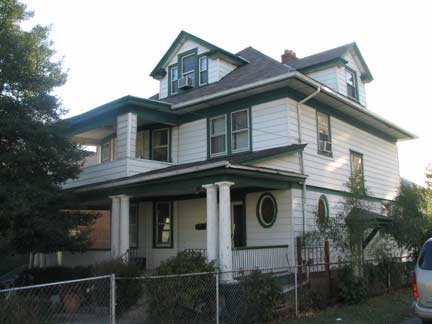
Nearby, on 161st Street, it’s an Old and New Flushing faceoff as one era confronts another. A relic with a porch on two floors, oval windows, and a wide lawn faces a new house with concrete lawn, exposed gas meters, and balconies that were rusting before the house was even finished. Sick transit, Gloria.
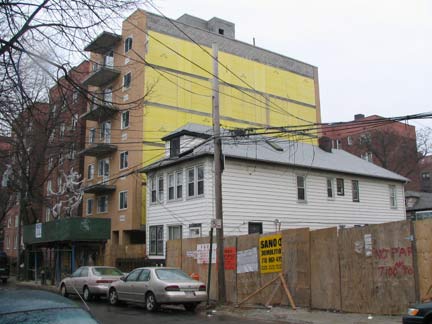
Hey, 43-22 Robinson Street: you’re about to become aQueens Crap sandwich!

163rd: plenty o’ parking here


45th Avenue and Robinson: the mark of un-quality.


Let’s see, exposed gas meters, check; concrete lawns, check; metallic doors, check; bland, anonymous brick facing, check; SUV parked in front, check. 155th Street north of Beech (left), 161st Street near 45th Avenue, right.
These are objects, not buildings. Rickert and Finlay are revolving in their graves.


Know your garbage. 43rd Avenue and 156th Street, 2006; Cherry Avenue near 147th Street, 1970s, right.
Important Post


In 2005 The Queens Historical Society and a local City Councilman (now the City Comptroller) unveiled a couple of restored gateposts at Cherry Avenue and Bowne Street with great fanfare.
Despite the ongoing destruction of Cherry Avenue, the local City Councilman had lifted neither a finger nor vocal cord in protest to what is going on in his district, but he liked gateposts that once marked a differently-themed neighborhood than the one that is currently replacing the present one.
A match made in heaven at 43rd Avenue and 162nd Street: a cinder-blocked law office next to a brand-new Fedders Special , with the usual accoutrements, like on-site parking.

… and (left) a brand new neighbor, just a half block away.


More charm-free Flushing construction.


43rd Avenue and 161st Street. Stripped and ready for the bulldozers.
Stumped me


An ongoing trend in formerly fab Flushing is the presence of a multitude of tree stumps. The developers and buyers of New Flushing are inexpicably house-proud, not apparently knowing anything better, and routinely cut down spreading shade trees so that people will get a better look at their babies. Of course, trees are the first things sacrificed at construction sites.
A Man’s Home Is His ….


The destruction of Old Flushing, and the creation of the New, isn’t limited to new monstrosities. The owner of building left, across the street from chez webmaster on 43rd Avenue and 159th, once had a gorgeous wraparound porch. Since these are no longer tolerable… he decided to wall in the porch.
At right, the building on 161st between Sanford and 43rd Avenue has been in this quarter-finished condition for over a year. Ugly two-toned brick has been added to the front, the beginnings of a deck, and garbage all over the lawn. Apparently his neighbors don’t mind; the guy to his right paved his lawn over last year.
Photographed July 2006-January 2007. Page completed January 14, 2007.
The destruction of Flushing has proceeded apace since then.



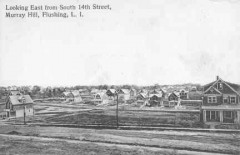









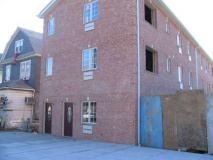




22 comments
My family moved to Flushing in 1964 from the Bronx. Moving to Queens was like moving to the country. We had lived in the Castle Hill Projects, surrounded by dirt and concrete. I was born and lived in the Bronx until I was 14. Grass, trees, geez even flowers! I cannot believe what it has become. I think they’re called McMansions have replaced all the beautiful homes. We moved to Bayside in 1974. It felt like it had when we first moved to Flushing. ALL GREEN!!!
I lived in Flushing from 1961 until 1989 Near Parsons and 45 th Ave. And it all started around 1980. I remember painting my fathers stucco sided house in August and my neighbor came by and told me that a man showed up on his door step with 350 K cash in a bag and offered it in exchange for the house on the corner. He accepted and with in a month 3 families were living in the house. On the other side of Parsons the houses were replaced with duplexes that have 2×4 and 1/4 in sheet rock walls separating the houses. And yes all the trees are gone form the street I lived on. After I left in 89 I went back a few times to more and more change. It really accelerated in 1997 when the half of Hong Kong could get out of China showed up. (The other half went to British Columbia) It will never be the same, the population density is way too high for what it was. I really enjoy your web site- you do nice work. 🙂
I too lived in Flushing and saw the changes over the years. I sold my mother’s house in 2002 and was thrilled to see it is still there today. The house behind it and across the street were made into multiple family dwellings. No grass, no trees, no place to park. Simply an eyesore in my beloved neighborhood at 45 Ave and 156 Street.
I have fond memories of walking and bike riding through the neighborhood. Flushing hospital, Main street,Kissena park, the Keiths and UA Quartet. All our favorite stores gone.
I know progress means change,but I miss the old Flushing!
It is very interesting that in other towns outside of the city i.e., Goshen NY that the old dutch colonial and early Americana architecture gets top dollar for those homes. But not here. The old homes of Flushing- although steeped in history and fine architecture are deemed worthless. There is a combination of sociological factors that is the force behind the destruction of Flushing that we are observing. The invasion by the various asian groups seek to diminish any evidence of an American past and to clearly establish a presence to their own liking and with architectural elements from back home that is tasteful to them- although vulgar and distasteful to many a local native born. And then there are the fences. Lots of fences extracts of the walled-culture that is so common “back home”. But nothing is stopping the asian developer from doing this. it does however sends a message to those residing in this community…that we the asians don’t care what you think because good chance we won’t be talking with you or associating with you, either your groups, your religion or by your culture. And there is no consequence for that behavior nor is there any encouragement to behave any different. In fact our local politicians incourage it.
Born in Jackson Heights, lived on Robinson Street, then Poplar Avenue, then 32nd Avenue. Loved and still love Flushing. Worked in Arcade Fruit Market while in high school, attended Drake Business School, lived in St. Mary’s Nativity Parish and attended their school. P.S. 24 during the summer break was a haven for play, we had back yards and front yards, played in the street, lived in Kissena Park, played ball in the ballfield, walked to Main Street, King Kullen then “the new” A&P, John’s Good Food store deli on Kissena THE BEST food, Gloria’s best pizza. One of 10, we were never lonely, never, ever made to feel unsafe, worked and babysat to raise money to see a movie at RKO or Parsons, learned to dance at 8th grade Catholic School – St. Mels, St. Kevins, Blessed Sacrament – sang “Bungalow Bar tastes like tar”; great childhood because we had terrific neighbors, adults that loved us even if we weren’t their own, and cemented in blood friendships to last a lifetime. Whatever Flushing looks like now, it sure was heaven – for us – then – today, it is still heaven, perhaps not the one we remember, for new arrivals, new families. La Vita e bella.
My family relocated from Birmingham, Alabama to 45-28 Bowne Street, Flushing in1948. I and 9 of my 10 siblings attended P.S. 24 which is located on Holly Avenue (46th Ave.) between Union and Robinson Streets. Five of us graduated from Flushing High School. Although there were other Black families located within our immediate surroundings, at that time, ours was the only Black family on our block in a neighborhood that was, predominately, working class Irish and Italian American. My Father was the Pastor of Macedonia A.M.E. Church, a historic institution founded in 1811. The church was surrounded by a Black community consisting of homes and businesses that was condemned to build a municipal parking lot that, until recently, completely surrounded the church. The first major transformation of Flushing, from the pleasant residential community that it had been, began in the early 1950’s. Jewish developers built co-operative apartments on the northeast corner of Kissena Boulevard and 45th Avenue populated entirely by Jewish families from Brooklyn and the Bronx. That began the building of a rash of non-descript 6-story rental apartment buildings throughout the neighborhoods of Flushing convenient to downtown Flushing. The occupants were predominately Jewish. One feature of Flushing that was beginning to disappear was the magnificent trees that graced the streets. During the Summer months, there were so many streets that were canopied by the overlapping leaf-filled branches of the trees lining both sides of the streets. The next transformation of Flushing began in the early 1970’s when South Koreans began to takeover businesses in the downtown area anchored by the intersection of Main Street and Roosevelt Avenue. They also began to buy residential homes and rent apartments throughout Flushing as they prospered and began to spread out. In the mid 1970’s, Indians discovered Flushing, built the first authentic Hindu Temple in the U.S.A. at the foot of my old block on Bowne Street, and have established a large presence in the community. Although Latin Americans have immigrated to Flushing beginning in the late 1980’s, they are not as large a presence as the Asians. The most dramatic re-making of Flushing has been the immigration of Hong Kong Chinese. Arriving with large sums of money, they have bought and redeveloped commercial and residential real estate particularly in the business district. Note that I have concentrated on the influx of immigrants, none of whom lived in Flushing during the 19 years I lived there, because they have been responsible for the most remarkable transformation of a very large community in the history of New York City. Unfortunately, they are also responsible for the accelerating conversion of what was a comfortable, uncongested, civil, attractive community into a congested nightmare. It’s a perfect example of the old adage, “You can’t go home.”!
There’s nothing like a “Fedders Special” ! This page was very depressing to read indeed. However, your great sense of humor made it much easier. This had to be posted.
My family moved to Flushing in 1947. I too remember the canopy of trees over 149th street. I remember the side of the street had tar on it and in the summer it got hot and sometimes had little bubbles in it. We used to break the bubbles with little twigs and got holy hell for getting tar on our clothes. My brothers and I went to Saint Mary’s and by the time we were ten we walked the seven blocks to school. It was a safe place to grow up. We would go down to Johns candy store on 45 Ave. and get egg creams. I remember his son Henry working there. There was Amaruso’s grocery, Bocks ice cream parlor, the “little park” across from Flushing Hospital. A wonderful place to grow up. I moved back in 1968 when I got out of the service. In 1970 I moved out to the Island. Spent a short time back there post divorce in the early 90’s and couldn’t wait to get out. In four years I never ran across any of the 60 kids from grammar school. I guess they all bailed out too. What a shame. Not safe, not clean, traffic horror show. When I think of the old days I understand the line ” For a time there was a place called Camalot”. My old house built around the early 1900’s is not a brick and chrome abomination.
Sorry, meant is NOW a brick and chrome abomination. Damn spell check !
Dallas
Hey Mike, I remember Bock’s Ice Cream Parlor very well! Their ice cream was the absolute best, it was homemade and very generously over-packed into paper containers! Not only could you get pints and quarts, you could get half-pints and a “gill” (pronounced “jill” – half of a half-pint, 4 ounces!). Also, several of my friends attended St. Mary’s and the original St. Mary’s church before the current sanctuary was built.
Hey – was just reading these posts abt old Flushing.. I lived there from 1952 till 1973. We lived just off Parsons Blvd next to St Mary’s School. Great memories and still stay in touch with friends from those times. Have lived in Europe and Asia but still feel my roots are back in Flushing.
progress? congestion! to beautiful queens, the boro that sported the most single family homes once, is now decorated with ugly box 3 and 2 family housing with 10 to 20 people occupying 2 and 3 apts ugh no solution but to move to the moon
I spent a good deal of my life in the Flushing Bayside area 25th & 48th ave for a while then 158th st and 45th ave, except for 6 years in Massapequa i was on 158th from 1970 to 1997 and i saw it change completely all my freinds and family left so i did also.
a few years ago a friends rather passed away so my brother and i did a drive through and i came away very depressed, i didn’t see anything that reminded me of my old neighborhood i was a very sad day.
SRY i ment to write 205th st
Just had to correct you. The house on the SE corner of Sanford ave and 161 street was made over by the original owners to gain income.
I grew up in Auburndale. Born in the 80s, and lived there until a few years ago. It was a nice area to grow up in. I never felt unsafe. I was fortunate to grow up in school district 25. One of the best! I went to P.S. 107,, I.S.
25, and then got accepted into the art program at Bayside High School. I made all my sacraments at St. Kevin’s. I return to the area, and miss some of the old stores, but… what can ya do? Times are changing. I guess it’s part of life. I can’t tell you how many times I had been to North Shore diner. Late nights out with friends, first dates, Sunday brunch with parents after church. Write back, so we can reminisce.
hahaha—i live in a huge monstrosity on Cherry Av—perhaps THE monstrosity Extraordinaire. A big tall piece of shit, willed with smelly garbage and bugs of all kinds, with a D rating on the energy scale. Flushing is a great name for what it’s become, I give it that. If Shithole were an olympic event, Flushing takes THE GOLD!!!!!
Looking for a picture of 147-17 Delaware Ave, Flushing, NY from 1970’s to 1980’s.
My grandmother’s home and place of family, love, holidays, celebrations. Memories. torn down for new Flushing NY? Why? Please send pictures if any exist to show my children and relive Memories thank you
Hi Mr Breslin, my name is Victor and I lived on Elm Ave around the block from your house, I grew up in the
50s and played on your grandmothers lawn with friends. I have a photo of your home but it is from 1939 and
nice. If you would like to have it I can send it to you by email.
Does anyone remember the name of the gift shop on the northeast corner of Northern Boulevard and 159 Street during the 1960s?
I lived to houses away from PS 24 and was late everyday to school. 45-32 Robinson St. We had a big pool in our backyard, every kid in the neighborhood who had a letter from their mom could come swim at the Stanger house , hahaha! Barbeques every weekend including the grownup Highball parties. Every neighbor watched out for one another. You could never get away with any shenanigans without hearing “I know your mother!”..
While trying to find old images of the Flushing I remember from 1956, I came across this site. I lived on 35th Avenue at 149th Street. Just as the webpage originator showed, Flushing was a beautiful town in which to grow up. I attended PS 22 which I think was a nineteenth century holdover that had been condemned when I was a student for 5th & 6th grades. In those days girls learned how to use sewing machines on which they made aprons and boys had shop. I had Miss Madden in 5th and Mrs. Villaverde in 6th.
Flushing’s late Victorian homes were all different. Our home had a wraparound porch whose railing I climbed on while walking and balancing carefully so I didn’t flip off into our front garden. The ceilings on
the first floor were 10 feet and in the bedrooms on the second were 9. The architectural details like the mouldings added character to the interior. The one big drawback in houses from this era were the size of the closets or lack thereof.
Just as has been stated previously, Flushing’s trees were a feature of this community. Flushing was known for its nurseries and its tree-lined streets. The sidewalk in front of our home had a permanent fracture from the tree roots that made it impossible to skate over. In the winter I’d bike to Bowne Park for ice skating. I can still see bunches of us on ice that was a little less than ideal, but enjoying every minute.
As I got older I attended Flushing High School which I loved. The high school itself is beautiful especially the original building with the gargoyles and the stunning auditorium. Main Street was our destination for friends meeting under the clock on Main Street on Saturdays, then off to Jahn’s Ice Cream Parlor or pizza, or a movie at the Prospect (I think). Also shopping in Gertz, if we had any birthday money or allowance savings. Sundays were reserved for St. George’s Church on Main Street.
Suddenly without any previous warning a developer bought the large house across from us, and put up either a 4 or 5 family a three story tall nightmare with no green space and no on street parking left,
because the driveways were inadequate for the number of residents. From then on getting in and out of our driveway was an exercise in maneuvering. As for Flushing Main Street, I drove by probably 20 years ago, and was stunned by the foreign language signs, the gates on businesses, and the shops no longer there. More recently I decided to l check on my former home. There was another multifamily, brick catastrophe where our home stood: not one tree, no lawn only grayscape. What a shame, and incredibly disappointing.
Anyone from Flushing High class of ’63, nice to reminisce. My maiden name: Dauria.
aso